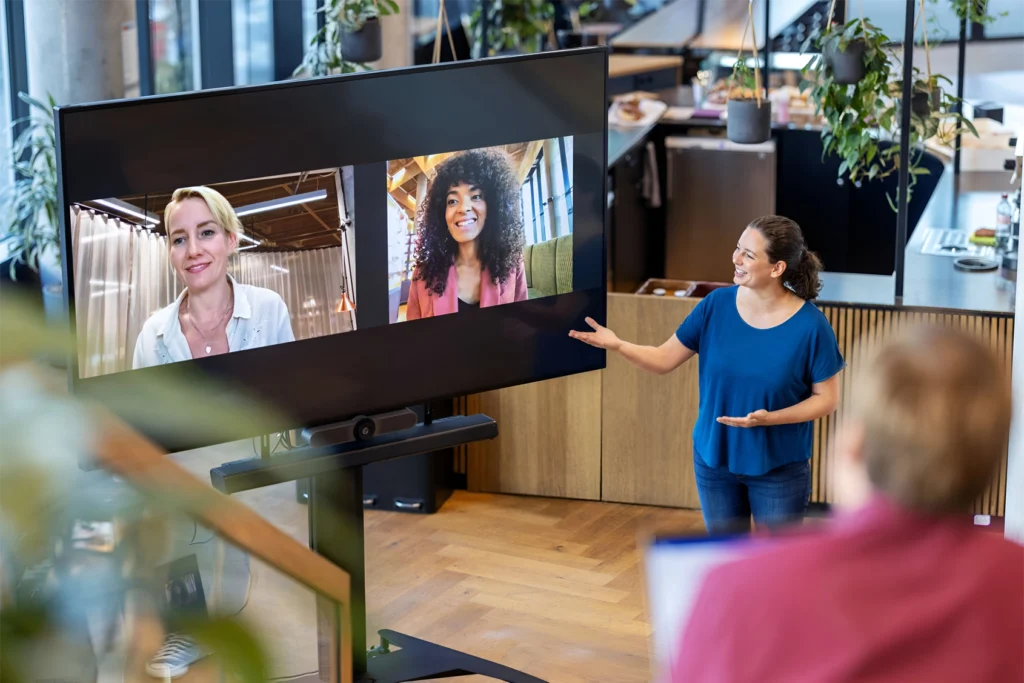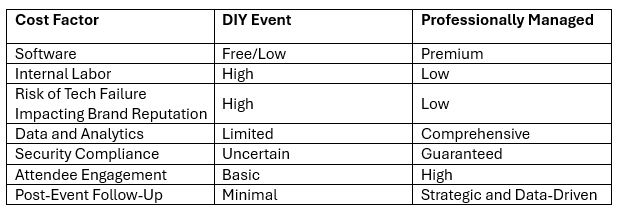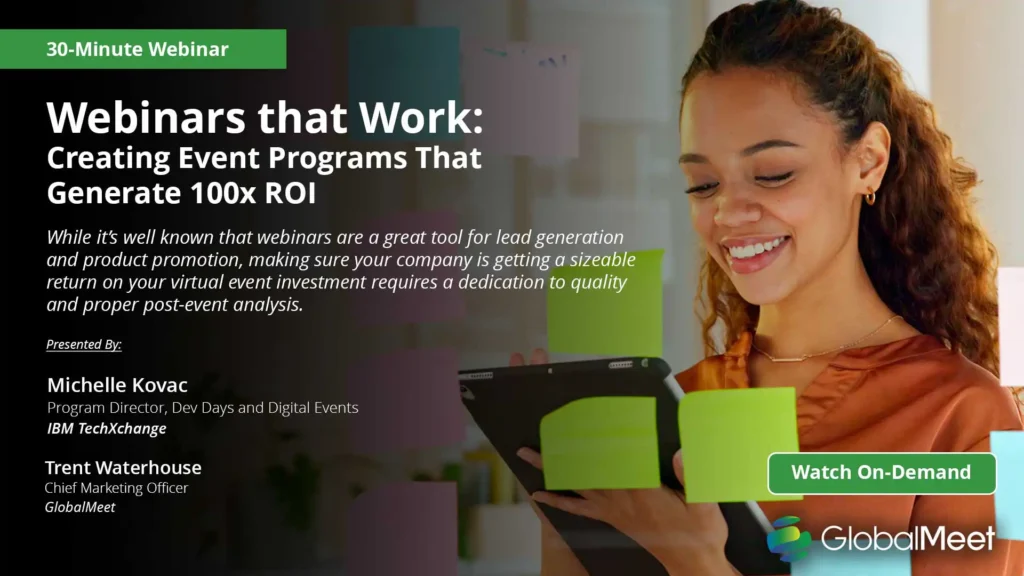
The Evolution of Virtual Presence: How Technology is Changing how we Show Up Online
- by GlobalMeet Blog Team
- ,
Over the last decade the phrase “virtual presence” has changed. What started as a phrase that simply referred to a person appearing virtually in a meeting is now a broader social concept that encompasses how we engage and connect in online spaces.
Today virtual presence is shaped by a blend of physical communication cues, virtual event platform capabilities, and a growing range of virtual event technology with a focus on immersive experiences. Instead of simply showing up, being present in a virtual space now means replicating at least some of the subtleties of real-life interaction, and as virtual events become more sophisticated, so do the challenges around authenticity, accessibility and security.
From Web Meetings to Digital Identities
The term Virtual Presence was originally used to literally refer to a person appearing on a screen. Early video conferencing tools such as Skype, Zoom, and WebEx focused on face-to-face communication through webcams and voice, prioritizing functionality over finesse. However, as virtual events have expanded in scope and scale the concept has evolved.
Today, being present in a virtual meeting goes beyond simply showing up; it requires engaging meaningfully with the content and interacting with others. Modern virtual events use a variety of tools to facilitate this presence, from surveys and polls to Q&A sessions and breakout discussions, all designed to help audiences engage in a digital space.
The Changing Expectation of Interaction
In 2021 Microsoft conducted research on virtual events and collaboration, and found that modern virtual event attendees want to participate and be present, rather than just mindlessly consuming content. With 90% of respondents stating that they wished to see their speaker, have active moderation in meetings and events, and be given opportunities to ask questions through a chat function, it’s clear that engagement is a vital factor.
Digital presentation has evolved to include more than our voice and image. Our choice of backgrounds, display names, profile pictures, and social media interactions combine to form a kind of virtual body language that impacts how we are seen by others in virtual spaces.
The Event Technology Tools Behind the Trend
When virtual meetings and events were first becoming commonplace the tools to support virtual presence and engagement were limited. Developments since then have been rapid, with enterprise grade virtual event platforms now featuring a wealth of tools and integrations to support event audiences with a variety of engagement options.
While not all engagement tools are appropriate for every context, particularly in strictly regulated environments like finance or pharmaceuticals, when they are suitable, they can allow for more dynamic virtual presence.
Engagement Driven Features
Virtual event engagement features help attendees to feel more than visually present by creating opportunities to actively interact, participate, and shape discussions.
- Live Polling and Q&A sessions allow attendees to have their voices heard in real time.
- Interactive Agendas and Personalized Schedules help users stay focused and involved by facilitating increased theme flexibility and choice
- Breakout Rooms create smaller, more focused environments for deeper discussion
- Chat Reactions and Emoji, while informal, provide quick, low-friction opportunities to engage.
Technology and Personalization
Developments in technology are helping make virtual presence smarter and more adaptive. From simple features like automatic lighting adjustment in webcam software and automatic noise reduction and audio enhancement, to AI integrations allowing for personalized content recommendations, technology is fundamental in shaping the way we show up online.
These developments are also enhancing accessibility, with features such as real time translation and captions break down barriers and allow audiences to be their authentic selves.
Avatars, AR, and AI: High Tech but High Risk
There’s a growing interest in the development of immersive technology for virtual spaces. Avatars, Augmented Reality, and Artificial Intelligence are on track to redefine virtual presence with fully immersive environments that allow event attendees to exist more physically in digital spaces.
However, these technologies come with serious security and compliance risks, especially in highly regulated sectors such as healthcare, pharmaceuticals, and financial services. With a growing concern around AI deepfakes and the potential vulnerabilities that could be created by an impersonation attack, many enterprise-grade event platforms are proceeding with caution, or not at all, when it comes to these tools.
Why Presence Matters
The way that we show up in virtual events directly influences how we are perceived by others. Just like in physical spaces, presence affects everything.
- Credibility and authority: A well-lit space, clear audio feed, and confident speech help build trust.
- Approachability and warmth: A warm tone, friendly query responses, and the use of some informal elements like chat messages and emojis can soften digital formality.
- Engagement and memory retention: Actively involved participants that are encouraged to engage are more likely to absorb and remember content
Virtual presence also affects the impact of the event itself. Organizers can analyze engagement metrics such as poll responses, questions, and time spent in sessions, to assess how well speakers and moderators facilitated authentic, engaged presence.
The Future of Virtual Presence
Current virtual event trends suggest that the future of virtual presence may rely less on verbal participation, and more on how participants contribute to a wide and complex network of digital interaction.
With smarter, more adaptive interfaces that allow greater personalization to enhance engagement, advanced integration with CRM tools for seamless transition between platforms, and enhanced security measures to help find a balance between creativity and compliance, technology is sure to remain a key factor in shaping how we show up online.
In the coming years virtual presence is likely to continue the path towards becoming entirely asynchronous, linked to our identities across multiple digital formats and platforms, rather than being a simple reflection of our existence in a single space.
Conclusion
Virtual Presence is evolving through more than updated cameras and smarter software, with shifting perceptions and changes to how we connect when we’re not in the same room. As virtual event technology matures it offers increased potential for more authentic, accessible, and interactive digital presence.
In the digital age presence is an omnichannel street, shaped both by the choices we make when we show up online, and the tools that we use to contribute and connect once we’re there.

Best Practices for Presenting on a Webcast: How to Engage and Impress your Virtual Audience
- by GlobalMeet Blog Team
- ,
Whether it’s delivering investor updates, hosting a thought leadership panel, or running internal townhalls, webcasting has become an indispensable part of modern business communication.
Unlike video meetings or webinars, webcasts support corporate events at a global scale, with attendees expecting a smooth, professional, and engaging experience from start to finish.
Running a great webcast takes more than just writing a script and going live. It’s a combination of the right software, good planning and preparation, and presenters who can engage and impress even the most diverse virtual audience.
Webcast or Webinar? Know Your Format
Before planning your virtual event, it is important to understand the key differences between a webcast and a webinar. Knowing which format will best suit the content you need to deliver will help shape preparation, tone, and technical planning.
Webinars
These are usually two-way, collaborative sessions used for training and workshops. They’re best for smaller audiences and groups as they offer a wide range of options for breakouts, discussion, and in the moment teamwork.
Webcasts
Webcasts are similar to a television broadcast. They’re designed for large audiences with a one-to-many format. Most webcasts will limit who can speak and present in any given session, with interactivity managed through panel Q&A and polling rather than allowing open discussion.
Preparation. Preparation. Preparation.
Even the most experienced speakers benefit from being prepared. More than reviewing slides and checking scripts, a presenter needs to understand the platform that they’re using, get comfortable with the format, and plan as many things in advance as possible.
By defining the core message that you want to communicate, the likely expectations of the attending audience, content duration and flow, and what interactive elements should be included, a plan for the session almost builds itself.
Every audience is different, and to engage them well as a presenter it’s important to align the content and presentation style with their needs. Tailoring your presentation approach early makes planning simpler, and helps everything run smoothly on the day.
Scripts and Supporting Media
A dynamic presenter is vital for a successful webcast, but supporting media is just as important. Scripts, slides, video clips, and downloadable resources can all support and enrich the audience viewing experience, but it’s important to ensure that they don’t overshadow the presentation.
Scripts
A script can be a huge help for presenters who prefer a reminder of their content, but it’s important to avoid reading a script verbatim. Keep scripts loose, with bullet points of key information to help stay on track while keeping delivery natural.
Slides
Slides help contextualize spoken content, but they can easily become distracting. Keep visuals clean and brand aligned, with limited text so that the audience remains focused on the presenter.
Video Clips
Pre-recorded clips not only give the presenter a break from speaking, but they provide a content shift that can boost attendee engagement. If using pre-recorded clips, ensure they are tested early to check compatibility and avoid technical issues.
Rehearse and Test Early
Rehearsal is one of the most overlooked aspects of the webcast preparation process. While having tech tests and dress rehearsals might seem like something that should be done a long time in advance, the best time for a full formal run through is within a week of the go-live date. This is close enough to ensure that platform layout, controls, and content all remain familiar, and far enough away to allow for last minute glitches to be corrected.
During rehearsals:
- Be in the space that you will be in on the day
- Practice transitions between speakers and segments
- Test facilitation tools for interactive elements
- Run through the full slide deck including any video clips
- Double check branding elements and visuals appear correctly on screen
The best rehearsals are ones that test like-for like, with every condition the same as it will be on the day for maximum scenario accuracy.
Consider the Presentation Space
Not every presenter has access to a studio, but taking the time to set up a clean, professional environment can still make a huge difference.
Camera Placement and Framing
- Position your camera at eye level to give a sense of natural eye contact
- Sit centered in the frame with a good amount of space above and around you
- Avoid wide angles as these can create a feeling of distance between presenter and audience
Lighting
- Use front-facing, natural light wherever possible.
- If a room does not have good natural light, a ring light or LED panel can help create consistent lighting
- Avoid overhead or backlighting as these can create harsh shadows
Audio
- Invest in a quality microphone for best audio quality
- Test audio levels well in advance, and mute any device notifications
- Avoid using integrated laptop or webcam microphones as they can echo
Background
- Choose a neutral or branded background
- Remove artwork or clutter that might distract the audience
- Avoid any reflective surfaces
Engaging the Audience
Event engagement matters, even in a broadcast style environment. Tools that facilitate engagement activities like polls and Q&A sessions can help to keep the audience invested and make for a more successful event overall. By combining engagement elements with custom player content and storytelling, a webcast becomes more than a static viewing experience.
Polls
The best way to keep audiences engaged is to include them in the session content. Using polls to gather real time feedback and check understanding is a great way to help attendees feel like part of the event, rather than passive viewers.
Q&A Sessions
Questions can be a great tool for building a relationship between presenter and audience, while enhancing knowledge and reinforcing understanding. Assigning a designated moderator to manage incoming questions and line them up for speakers can help these sessions to flow smoothly.
Player Content
Enterprise grade platforms facilitate the inclusion of downloadable resources, custom tabs, and links with related information and further reading. These features enhance the viewer experience by adding context to the delivered content.
Storytelling
Facts tell; stories sell. It’s an old adage that remains true in the digital age. By sharing real life anecdotes, client success stories, or personal reflections you can build an emotional connection with the audience that keeps them listening to what you have to say.
Becoming a More Natural Speaker
There are some people who seem born for public speaking, but the rest of us often need a little practice. When it comes to finding confidence as a speaker and easing nerves there are numerous techniques that can help.
Speaking with Confidence
- Smiling has a number of psychological benefits for reducing stress and improving mood. It can also help you appear more open and approachable as a presenter.
- Stand up. Standing up with a strong posture doesn’t just give the appearance of confidence. Studies show that standing can also make you feel more confident.
- It might be tempting to keep your hands in your lap, but gestures can provide emphasis that makes your delivery naturally more dynamic.
Managing your Nerves
- Knowing your content and knowing it well makes it less likely that you’ll make a mistake or go off track. It can also make questions less daunting.
- Breathing deeply is inherently calming and taking a few deep breaths before you begin presenting can help settle those starting jitters.
- Speaking quickly accelerates nerves, and shows them to the audience. Practicing pauses and getting comfortable with silence can help you feel more in control.
- Be you. Audiences respond well to humanity, and nerves are human. Letting your personality come though can aid connection, and feeling connected reduces nerves.
What to do When Things Go Wrong
Even with the best preparation, things can still go wrong. Microphones cut out, slides crash, internet drops, and videos lag. So, it’s important to plan a backup in advance.
Managed webcast providers will often assign an event production team who can assist before, during, and after events with set up and running. These producers can troubleshoot in real time, handle moderation and transitions, and keep everything on track behind the scenes so presenters can focus on content.
But even with a managed service, additional backups are important. Having a copy of slides and videos to hand, a plan for switching to a new presenter if someone drops, and a backup internet connection prepared in case of failure can all help to keep an event running smoothly on the surface, even if things are going wrong behind the scenes.
Conclusion
Being a good presenter is more than being a good speaker. Engaging a virtual audience requires preparation, tech setup, and interactive elements, as well as speaker confidence. The best presenters are those who rehearse thoroughly, plan for the unexpected, and engage with attendees through story and connection. Professional and polished, even when things go wrong.
Preparing for your own webcast?
Download our Webcasting Presentation 101 quick reference guide today, and enhance your planning with a four week readiness timeline and curated expert presentation tips.

Virtual Compliance Training: Ensuring Security in Financial Conferences
- by GlobalMeet Blog Team
- ,
In the highly regulated world of financial services, regulatory compliance isn’t just a legal necessity. Financial institutions operate in a high-stakes environment where the cost of compliance failure can be catastrophic to business integrity, customer trust, and operational stability. As the industry increasingly embraces virtual events and online training, the question of how to maintain compliance and data security in virtual environments has become more important than ever.
Virtual compliance training is a scalable, efficient, and effective method for educating employees on financial regulations. But, while the benefits are clear, delivering regulatory training virtually introduces a unique set of challenges around cybersecurity, engagement and content control.
Why Regulatory Training Matters
The financial industry is one of the most highly regulated sectors across the globe. With regulators such as FCA, PRA, and FPC, complex anti-money laundering directives, and oversight from OCC and the SEC, the volume and complexity of financial regulations requires regular, monitored training.
The Cost of Non-Compliance
Poor or inconsistent adherence to regulatory compliance can be costly, with the estimated global regulatory fines in 2024 reaching a record breaking $19 billion. However, these fines — though severe — aren’t always the result of deliberate non-compliance. They are more often mistakes caused by misinterpreted legislation and under-trained employees.
Not only are these mistakes costly, but they can also damage company reputation, impact share process, and lead to the loss of customer trust.
Mandatory and Continuous Training
Unlike simple one-off training sessions, regulatory compliance training must be updated continuously as laws change, threats evolve, and the industry implements additional protections. Institutions must therefore ensure that their employees stay informed and compliant with regular ongoing professional education.
The Shift to Virtual Compliance Training
As technology evolves so has the training that relies on it. Training sessions, workshops, and full-scale conferences can now all be run virtually, presenting significant opportunities for the organizations that choose to do so.
Virtual compliance events can be scaled to meet the needs of the institution, be it for hundreds or thousands of employees at a time, with minimal cost and logistical strain. They are flexible, fitting around individual schedules and increasing accessibility across global time zones. Running regulatory compliance events virtually also increases the potential data collection opportunities, allowing for deep analysis of engagement in, and completion of, compliance training.
However, these benefits are not without their associated risks.
Security Considerations
Virtual events offer increased convenience and flexibility, but they are also susceptible to a diverse range of security threats.
Hacking and DDoS Attacks
Cyber-crime is on the rise, with cybercriminals increasingly targeting virtual financial events. A Distributed Denial of Service (DDoS) attack can shut down virtual events platforms, disrupt training, and potentially expose confidential data.
Unauthorized Access
Without secure access controls unauthorized individuals may be more able to enter secure training sessions or other internal events. This access, whilst generally disruptive, also significantly increases the risk of data breaches and the loss of stakeholder trust that follows.
Content Leaks
It may seem trivial to be concerned about training content leaks, however internal training materials regularly contain sensitive information regarding company procedures, risk management protocols, and lessons learned from previous incidents. If such content was recorded, downloaded, or shared, it could increase the risk of further attacks, as well as resulting in serious compliance breaches.
Best Practices for Secure Training
While it may not be possible to entirely eradicate the risks associated with virtual training events, with the right tools, protocols, and platforms organizations can maximize both security and compliance.
Role Specific Sessions
Instead of running broad, generic modules, best practice suggests that it is better to design specific training sessions that are aligned to individual job roles. This not only makes the training materials more relevant, but also helps to ensure that only the participants who need certain information can access it, reducing the risks of internal leaks.
Interactive Learning
Traditional compliance training is often dry and uninspiring. A checkbox exercise to be completed as quickly as possible and put aside until the next mandated session. This can significantly increase the risk of poor information retention, leading to costly mistakes down the line. By incorporating interactive training techniques such as scored quizzes and knowledge checks, learning outcomes can be improved and compliance easily demonstrated.
Authentication and Access Control
Password protection is no longer enough. A more secure approach is to use Multi-Factor Authentication (MFA) and Secure Sign On (SSO) protocols on all platforms to protect against password hacking. Many platforms also allow access limitations based on job roles, and can track logins for threat detection and tracing.
Content Protection
Though it is often helpful to be able to download training materials for future reference, this feature should only be available with appropriate permissions. Making use of digital rights management tools to restrict recording and screen-capture tools, along with watermarking downloaded content with unique user information, can also help to protect data and deter leaks.
A Personal and Practical Approach
Effective compliance training should go beyond ticking boxes. By creating a culture of personal accountability, ethics, and awareness, organizations can mitigate some compliance risks early in the employee journey.
Combining this organizational culture with practical training sessions based on real world examples, and information that makes the implications of non-compliance tangle, the gap between policy and practice can be bridged leading to higher compliance standards overall.
Choosing the Right Virtual Training Platform
Technology plays a central role in the delivery of secure and effective training. Enterprise Grade Virtual Training Platforms provide a suite of features to enhance both security and compliance in every event.
Scalability and Customization
Your chosen training platform should support not only your current numbers, but be able to scale with you as your organization evolves and grows, without compromising performance or security.
The best platforms also offer customizable branding options and dedicated event portals, allowing you to keep a consistent brand across all materials for seamless, professional events.
Reporting and Analytics
Regulatory bodies frequently require evidence that training has been completed, and by whom. It is therefore important to choose a platform that provides detailed audit logs and reporting, so that you can see who has accessed and completed training, and when.
Platforms should also offer completion-based certification, and user engagement analytics options to ensure that you have all the information you need about your student journey.
Engagement Features
Compliance content shouldn’t be boring. Look for a platform that offers a variety of diverse events and engaging content. Tools that allow for interactive case studies, knowledge checking, Q&A or live chat, and polling options can significantly increase engagement and participation.
Secure Infrastructure
The security infrastructure behind any platform directly impacts the security of the events it can run. It is important to ask any proposed supplier about:
Servers and Hosting. Do they own their own servers or cloud infrastructure, in ISO 27001-certified facilities, to reduce cybersecurity targeting risks?
Access Protection: Do they restrict user access by IP or email domain, and prevent multiple logins using the same email address? Do they support Multi Factor Authentication and Single Sign On?
Data Protection and Compliance: Do they support end-to-end encryption to safeguard data? Can they control content distribution through viewer specific access? Do they meet key compliance requirements such as GDPR, CCPA, and SOC 2?
If a provider cannot meet these security requirements, it may be worth considering an alternative or backup solution.
Conclusion
Virtual Compliance Training is not a nice-to-have, it is a regulatory necessity in the modern financial landscape. When delivered effectively and securely it can empower employees, strengthen regulatory positions, and significantly reduce the risks of data breaches and penalties. And in an industry where mistakes can cost millions of dollars, ensuring that your compliance training is both effective and secure is business critical.

Microlearning in Virtual Events: Short Sessions for Improved Retention
- by GlobalMeet Blog Team
- ,
In the digital world attention is a scarce commodity. Social media, shortform video, and the ability to find information in a matter of seconds have left attention spans dwindling and engagement harder than ever.
This shift is having a significant impact on the many organizations that rely on virtual events for Continuing and Professional Education. Long, drawn out presentations are giving way to short, bite sized microlearning formats that keep attendees engaged for longer and support better knowledge retention.
What is Microlearning?
Microlearning is an educational approach that prioritizes delivery in short, focused bursts rather than longer sessions. The average microlearning session lasts 3-10 minutes, with a priority on easily digestible and memorable content. With information broken into smaller, structured modules this method of learning has proven particularly effective for remote learning environments, virtual conferences, and digital training programs.
The Science Behind Microlearning
Attention Spans are Shrinking
With the rise of smartphones and social media, the average human attention span in the last twenty years has shrunk from 2.5 minutes to 45 seconds. This significant drop in attention is making it harder than ever to engage virtual audiences via traditional learning methods, and is encouraging organizations to transition to alternate formats.
Utilizing the Ebbinghaus Forgetting Curve
One of the key theories behind the science of Microlearning is the Hermann Ebbinghaus Forgetting Curve. Ebbinghaus studied memory decay without reinforcement, and discovered that:
- 50% of information was forgotten after one day
- 90% of information was forgotten after one week
Combined with the audience memory curve, which suggests that audience attention peaks at the beginning and the end of a presentation, while dipping in the middle, it become clear that traditional methods are no longer suitable for modern audience.
Microlearning helps to counteract this information loss and anchor information into long term memory by delivering information in short segments and building in regular reinforcement through quizzes, polls and recaps.
The Benefits of Microlearning
Flexibility and Convenience
One of the biggest strengths of microlearning is its flexibility. Learners can consume content at their own pace, on a schedule that works best for them. For continued professional education events that span multiple time zones, microlearning modules offer an accessible, convenient learning experience that increases the chance of core objectives being fulfilled.
Learner Preference
Modern learners, especially younger professionals, express a preference for shorter formats. With the rise in popularity of shortform content in both video and text platforms, the preference in training has also shifted to mirror these trends. Microlearning satisfies the desire for shorter content, aligning professional development with the technological standard.
Cost-Effective and Scalable
The benefits of Microlearning aren’t just for learners. Even for the most experienced teams developing long-form training content can be both expensive and time-consuming. Microlearning modules are typically easier to produce, update, and repurpose when compared to their longer form counterparts, which can increase their overall ROI.
Best Practices for Structuring Microlearning Content
Creating microlearning content takes more than chopping up existing materials into smaller segments. To make the most impact with microlearning content you should:
- Stick to one objective per module: Keeping focus on a single learning objective will make the content easier to absorb and remember.
- Use a variety of media formats: By using a mix of short videos, infographics, speakers, and slides, you can improve retention and cater to a range of learning styles.
- Make use of interactive elements: Tools like polls and quizzes can encourage participation and reduce screen fatigue.
- Incorporate storytelling: Incorporating case studies and scenarios in a narrative arc is a great way to create engagement.
- Reinforce and repeat content: Revisit key points multiple times through the session in different ways to boost retention.
Implementing Microlearning in Virtual Events
Enterprise grade virtual event platforms are making it easier than ever to implement microlearning techniques into virtual events. With integrated engagement and analytics features, and customizable portals to keep everything in one place, the right platform can transform your CPE approach.
But the right platform alone isn’t enough without implementing the principles of microlearning.
Build in Recaps
Rather than delivering content in one long session, break it down into short segments with recaps and key takeaways built in. Adding polls and Q&A sessions can also help to reinforce learning and create an active learning environment.
Intermittent Testing
Instead of saving assessments for the end of a course, adding knowledge checks at the end of each segment provides instant feedback and supports active learning.
Mix Video Clips and Live Speakers
Changing content format through the course of a session can also boost engagement. Using a mix of pre-recorded videos and live speakers, with supportive infographics and dynamic slides can also reduce mental fatigue, leading to better outcomes overall.
Schedule Short Breaks
Planning in short, timed breaks between content segments is vital. These can be simple comfort breaks for learners to fresh themselves, or guided sessions that encourage mindfulness and wellbeing exercises to reset focus.
Conclusion
Microlearning isn’t a passing trend, but an evidence-based answer to modern learning challenges. When implemented well, microlearning can turn passive CPE broadcasts into dynamic learning sessions that support continuous professional development objectives and individual learning styles.
With the continued trend of content getting shorter, and attention spans shrinking with it, event planners should also be thinking short. By using microlearning strategies you can help virtual audiences stay engaged, retain information, and get more out of your CPE events.

The Hidden Cost of Inefficient Events: What Poor Planning Really Costs You
- by GlobalMeet Blog Team
- ,
When planning a virtual or hybrid event, it’s easy to focus on the obvious expenses. Venue, platform fees, speaker costs, marketing, and staffing are all common budget lines in the events planning world, but these planned outgoings are only part of the story.
Hidden inefficiencies like poor workflows, disconnected tech stacks and misaligned teams don’t just stretch timelines; they inflate budgets, drain morale, frustrate attendees, and ultimately lower the overall value of your events.
What Makes Events Efficient?
Inefficiency isn’t always obvious. An event can run smoothly on the surface and still be chaos behind the scenes, losing organizations time, money, and opportunity. When planning an event there are two main areas where hidden costs can often be found: technology, and workflows.
Choosing the Right Tech Stack
The right event management tools can help alleviate a lot of the stress that comes with event planning, but that doesn’t automatically generate efficiency. If your tech stack isn’t streamlined — with every element working seamlessly together — it can result in duplicated data, disordered analytics, and a frustrated events team.
When considering the potential technical issues associated with event platforms, and the training required to accurately troubleshoot and overcome them, a solution that looks efficient on the surface could still result in increased overhead and reduced attendee satisfaction.
Streamlining Workflows
Any event planner knows that events are a complex map of moving parts, and if your workflows aren’t streamlined, a small problem can quickly escalate.
Manual prosses that could be automated increase staff hours exponentially over the course of an event. Communication issues between teams slow down the planning process, and lack of clarity around responsibilities and timelines can cause task bottlenecks and costly last-minute changes.
Most workflow setbacks aren’t the fault of any one person or team, but without proactive management and the right tools to support your event behind the scenes, they can become significant drains on already stretched resources.
Tangible Costs
Many of the impacts of inefficient event planning will show in event budgets, even if it’s not immediately clear.
Budget Overspend
Changing plans last minute, extending project timelines, or needing to bring in additional support under pressure will all inflate budgets. When budgets are exceeded due to inefficiencies it can be harder to prove return on investment and justify future event investment.
Last Minute Troubleshooting
Poor initial planning leads to last-minute emergencies. Whether it’s patching tech problems, replacing keynote speakers, sourcing accessibility integrations, or manually migrating data between platforms, last minute troubleshooting adds additional pressure to internal staffing teams while increasing costs.
Wasted Staff Hours
Your team is one of your most valuable resources. When staffing hours are increased solving preventable problems, sifting through data, or duplicating tasks due to inefficient workflows, you’re spending more without significant gain. When those additional hours are multiplied across months of planning, the costs soon add up.
Intangible Costs
These costs won’t show up on an invoice. Some of the worst impacts of inefficient planning are invisible at first, but they can ripple through both your organization and your audience.
Brand and Reputation Damage
When an event attendee has a negative experience, be it through technical issues, or inaccessible content, they associate that experience with your brand. A single mismanaged event can undo months of positive engagement activity.
In virtual and hybrid environments, where contact is limited, the event platform and the experience that it provides is everything. An event that feels clunky to the end user can damage brand credibility and deter future attendance.
Data Loss
Virtual events can generate a significant amount of data, and if used well that data can be a powerful tool for audience engagement and continuous improvement. However, when platforms aren’t integrated or teams can’t access the information they need, vital strategic information is often lost.
Staff Morale and Burnout
Inefficient planning is frustrating. Be it constant firefighting, lack of clarity, repeated issues can wear down even the most dedicated teams. Over time this can create disengagement and employee burnout, increasing costs in turnover, training, and a loss of institutional knowledge.
How to Improve Event Efficiency
Improving the efficiency of your events doesn’t come from working harder, but from planning smarter. With the right tools, and intentional, proactive preparation, you can transform your events process, saving time and money.
Proper Prior Preparation
The mantra might be old, but the message is just as relevant in the age of online events. Take time to:
- Map out event timelines early
- Clearly define staff roles and responsibilities
- Identify risks and create contingency plans
- Choose tools that integrate well
- Build in time for platform testing and training
- Run rehearsal sessions for speakers and internal teams
- Review and implement lessons learned from past events
With good preparation and strong planning, the stage will naturally be set for smooth event execution.
Choose the Right Platform
Your chosen event platform should be more than a simple hosting tool. Enterprise grade event management tools act as your event command center, with integrated tools for registration, communication, analytics, and accessibility all in one place. This eliminates the need for switching inefficiently between systems, leaving you with an event planning process that is smooth and stress free.
The right virtual event platform should also scale seamlessly with you — whether your event draws in a thousand or ten thousand attendees — and feature an intuitive user interface that showcases your unique brand, allows you to focus on what really matters.
Leverage a Managed Event Service
While it might be tempting to run every aspect of your event in-house, there are a number of reasons to choose event assistance from experienced experts to complement and enhance your team’s production and your audience’s engagement. It might seem like a significant cost, but with event experts, guided rehearsals and practice sessions, and dedicated tech support both before and during your event, the benefits are significant.
Having a managed service ensures that your events run smoothly, minimizing the risks of reputational damage and ever-increasing scope creep, and allowing your teams to focus on delivering quality events.
Focus on Value not Revenue
Efficiency isn’t just about cutting costs; it’s about maximizing event value. A well-run virtual or hybrid event can increase value in every area.
- Higher attendee satisfaction
- Better engagement and retention
- Stronger band perception
- Actionable data insights
- Greater long-term impact
When you measure success by the value created, not just the revenue earned, it’s clear to see how crucial efficient event planning really is.
Conclusion
Every event incurs costs, but inefficient planning can inflate budgets in ways that are hard to identify until it’s too late. The solution isn’t as simple as increasing initial budget or adding a new toolset, but requires a holistic assessment of all event elements. By addressing planning, tech, and workflow issues early, you can protect your budget, safeguard your reputation and, deliver more impactful attendee experiences.

Operator Assisted Teleconferencing: Why GlobalMeet Still Delivers
- by GlobalMeet Blog Team
- ,
Modern technology solutions are constantly evolving, and with that evolution often comes the obsolescence of previously vital services. With the corporate shift towards video-based communications, and the evolution of event technology, many traditional telecoms service providers are decommissioning Operator Assisted Teleconferencing services, leaving the organizations that still use them searching for replacement solutions.
GlobalMeet recognizes that for many high-stakes events — from board meetings and investor calls to town halls and crisis communications — Operator Assisted Teleconferences are still a vital business communication tool, so we continue to invest in and enhance our OA offerings to provide a secure, global service.
Why Are Providers Retiring Operator Assisted Teleconferencing?
Operators to Algorithms
Running a network of live operators and managing human-assisted logistics can be costly. With telecom giants facing decline in average revenue per user it’s no surprise that that some are favoring automation in place of human functions as a means to save costs.
With self-service, automated platforms providers can reduce overhead and streamline operations, while remaining up to date with technological advancements and combating narrowing margins.
Demand Decline
With a decrease in demand for more traditional teleconferencing services, business are increasingly moving towards more scalable automated virtual communication platforms that support rapid deployment with minimal human intervention required, even for large scale events.
Combine this demand change with increased pressure from the FCC around accessibility integrations, which promote video as a communication tool, and the potential that video conferencing offers to remove the requirement for paid additional support systems such as Video Relay Services, and it is clear why so many are making the switch.
Infrastructure Constraints
With the advancement of technology comes the requirement to upgrade technological infrastructure. Unfortunately these upgrades are both costly and time consuming, and the increased operational challenges that come from managing legacy networks for services are often not considered cost effective.
Combined with the fact that more than 80% of telecoms providers cite aging infrastructure as an innovation restriction, it becomes clear that legacy operator-assisted systems are being left behind in favor of more flexible, modern solutions.
Operator Assisted Conferencing Still Matters
Despite the rise in industry automation and the retirement of many services, human assisted conferencing remains essential in areas that demand reliability, control, and security.
High Profile Events and Board Meetings: High profile events demand flawless execution, from guest entry management to topic and speaker introduction, in these events presentation is almost as important as the content itself. An Operator Assisted service provides the poise and precision that automation lacks.
Investor Relations and Earnings Calls: Investor confidence is built on a foundation of clarity, professionalism, and security. Live operators protect confidential information with audience vetting, keep messaging clear and on-topic with moderated Q&A sessions, and bring a wealth of experience to enhance the overall experience.
Large Scale Corporate Events: Often supporting thousands of participants, large scale corporate calls can be very quickly derailed by even small errors leading to brand and reputational damage. With an Operator Assisted call, technical difficulties can be managed in the background without interrupting the event, helping to maintain operational excellence.
Rapid Release Crisis Communications: When a crisis occurs having the ability to quickly and securely communicate with the right people is vital. With an Operator Assisted Call service providing expert behind the scenes support your message can move at pace, allowing you to secure the narrative without compromising quality.
GlobalMeet: Your Purpose-Built Solution
While many operators are abandoning Operator Assisted Conferencing, GlobalMeet continues to invest, innovate, and deliver scalable, professional conference call solutions with a range of features to support a broad range of industries.
Live Call Management
- Operators professionally welcome attendees and introduce speakers with polish and clarity.
- With operators facilitating Q&A sessions to ensure that questions are queued and managed in real time, flow is maintained and confusion reduced.
- Our dedicated behind the scenes event operators handle logistics, troubleshoot issues, and ensure uninterrupted execution from pre-conference to post-event wrap ups.
Flexible, Global Access
- Share your message globally with toll free conferencing in over 45 countries
- Ensure that only the right people can access your events with three flexible and secure connection options.
- PIN Secured Entry with pre-registration for simple guest login
- Operator Greeted Entry for an elevated professional experience
- Browser based Click-to-Join Entry for flexibility wherever your audience are
- Support accessible attendance with Operator Dial-out services
Webcast Integration
- Integrate with the GlobalMeet Webcasting platform with synchronized audio and video for cohesive multi-platform messaging
- Seamless, scalable streaming options on phone or browser to help every participant remain connected.
Post-Event Analytics and Reporting
- Comprehensive post-event data reports allow you to track participant attendance, usage metrics, call duration, and engagement insights so you can make the most of every call.
Extend the life of your call and support regulatory compliance with conference call transcripts, recordings, and translations.
Conclusion
Despite the evolution of corporate communications, operator assisted conferencing remains far from obsolete. With expert supervision, professionalism, and adaptability, these calls provide a bespoke service that automated systems often cannot match.
GlobalMeet is committed to retaining and investing in our expert operators, prioritizing secure and private infrastructure upgrades, and offering scalable, flexible solutions to support and develop these essential enterprise services.
When your message matters, GlobalMeet Delivers.

Virtual Events: Why Should You Choose a Professionally Managed Virtual Event Platform?
- by GlobalMeet Blog Team
- ,
Modern businesses are increasingly expanding to meet the needs of global audiences, and virtual events have become essential for everything from product launches to internal conferences as a result. With this increased demand comes a plethora of do-it-yourself events tools, all promising a user-friendly, simple experience so that any business of any size can work on a global scale.
These basic and inexpensive platforms are often tempting for budget conscious businesses who still want to keep ahead of the competition. After all, how hard can it be for a small in-house team to run a webinar or a livestream? But the truth is, while DIY virtual events may seem like a cost-effective solution on the surface, they often come at the price of reduced engagement, technical hiccups, and missed opportunities for impact.
That’s where a professionally managed virtual event platform comes in, offering not only technological support, but strategic value that can transform a simple digital gathering into a compelling, secure, and measurable experience.
The Pitfalls of DIY Virtual Events
Many organizations dive into virtual events using familiar tools like Webex, Zoom, Teams, or Google Meet. These platforms are great for small meetings, but they simply weren’t designed to support larger-scale events or conferences with 1,000+ attendees, and fall short as a result. Investing in Teams Town Hall, Webex Events (formerly Socio), or Zoom Events comes at significant additional cost.
Limited Interactivity
Basic platforms are just that. Basic. They rarely offer advanced features like real-time polling, live Q&A with moderation, or interactive breakout sessions to keep attendees actively involved in the sessions. This shortfall limits audience engagement and can lead to passive, forgettable experiences as a result.
Poor User Experience
Without dedicated support on hand, technical issues like audio glitches, lags, or broken links can derail even the most well-planned event. Plus, standard web meeting tools can’t offer bespoke branding or customization options, which can leave your events feeling generic at best, or unprofessional at worst.
Security and Compliance Risks
Though it might seem like a cost saving to use an existing platform, DIY setups often lack the security infrastructure required to meet GDPR, SOC 2, or other data protection standards. This gap puts sensitive attendee data at risk, and leaves organizations potentially liable for substantial fines.
Overburdened Internal Teams
Event planning is complex, even for events that aren’t virtual. Adding the responsibility of managing technology, troubleshooting live issues, and monitoring attendee engagement for each session stretches your team thin, increasing the chances of error, reputation damage, and employee burnout.
Minimal Reporting and Analytics
Tracking success after the event becomes difficult without built-in analytics and CRM integration. How many attendees dropped off early? Which sessions generated the most interest? Did anyone sign up for post-event information? Without this data, you’re flying blind, and missing out on potential ROI.
Why Choose a Professionally Managed Event Platform?
A professionally managed event platform doesn’t just provide better tech — it provides a better experience, both for attendees and your internal teams. These solutions are built to scale, customize, and optimize every aspect of your event, with expert support at every stage so you don’t have to worry.
Advanced Features and Interactivity
Enterprise Grade Virtual Event platforms offer a host of integrated engagement tools:
- Interactive Agendas
- Moderated audience chat and Q&A’s
- Live polls and surveys
- Real-time content sharing
- Live translation integrations.
These features keep attendees on a national, or global level, actively involved in the content that you want to share.
Custom Branding and Professional Polish
Professionally managed virtual event services enable a fully branded event — from landing pages and emails, to in-platform visuals. Giving your attendees a cohesive, high-quality experience that’s aligned with your organization’s unique brand identity.
Dedicated Support and Technical Management
From onboarding to real-time support during the event, a managed solution takes the technical burden off your internal team. Event managers, producers, and support staff handle all the key details, so you can focus on content and strategy without any additional stress.
Enterprise-Level Security and Compliance
When searching for a managed virtual event platform, it is essential to ensure compliance with the security standards of even the most regulated industries. The best virtual event platforms boast:
- End-to-end encryption
- Secure login features such as Multi-Factor Authentication and Single Sign On capability
- Access controls and Recording Restrictions
- Secure content distribution networks
- GDPR, CCPA, and SOC 2 compliance
Professionally managed platforms with enterprise-grade security measures ensure that your audience’s information is protected, and your brand reputation remains intact.
Post-Event Analytics and Sales Enablement
Professionally managed platforms often integrate with existing CRM platforms such as HubSpot or Salesforce to track attendee behavior in as much or as little detail as you need.
With lead scoring metrics on who attended which sessions, how long they stayed, what questions they asked, and which downloadable resources were accessed, you’ll be able to begin post-even follow-ups seamlessly.
Time and Resource Efficiency: Do More with Less Stress
One of the most overlooked advantages of a managed virtual event solution is the time it saves your internal teams. Instead of pulling in staff from marketing, IT, operations and customer relations to manage logistics, your team can stay focused on the things that really matter.
By allowing the professional events team to handle everything from platform setup and rehearsal, to livestream management and tech support, you not only provide your attendees with more seamless experience, but reduce internal stress and while increasing productivity.
ROI Comparison: Cost vs. Value
At first glance, a professionally managed virtual event platform may seem expensive compared to free or low-cost tools. But consider the full picture.

When accounting for the total value — reduced man-hours, improved brand reputation, better audience engagement, and measurable outcomes — the ROI of a professional solution is far more favorable than it might initially seem. When a professionally managed event delivers 10x / 50x / 100x return on the marketing investment through new business demand generation because of the analytics and reporting data – the focus on cost inevitably shifts to a focus on profitable revenue growth.
Conclusion
In a competitive digital landscape, the quality of your virtual events reflects directly on your brand. While DIY tools may seem appealing for their simplicity and low cost, they often fall short in areas that matter most. Engagement, professionalism, security, and insight.
Investing in a professionally managed virtual event platform isn’t just a tech decision, it’s a strategic one. It’s about delivering seamless, engaging experiences that resonate with your audience and drive results long after the event ends.

Maximizing the Benefits of Virtual Events in the Tech Industry
- by GlobalMeet Blog Team
- ,
The tech industry has always been a leader in embracing digital transformation — especially when it comes to connecting people. Virtual events, once considered a contingency plan and nothing more, have become a core strategy for tech companies worldwide. Whether it’s hosting a virtual networking event, launching a new product, or running a global developer conference, tech firms are discovering that virtual events are not just convenient alternatives to in-person gatherings — they’re opportunities to engage with global audiences in smarter, more scalable ways.
The Evolution of Virtual Events in the Tech Industry
While early virtual events were often simple webinars with slide presentations, the landscape has changed rapidly in the last five years alone. Innovations in event technology, audience engagement tools, and immersive platforms have helped tech companies shift from passive broadcasts to fully interactive digital experiences.
Today, tech industry virtual events are highly strategic, built around community-building, knowledge sharing, and thought leadership. Savvy corporations have embraced hybrid and virtual-first approaches, reaching audiences at scale while cutting down on logistical overhead. These events aren’t just live streams — they’re dynamic ecosystems offering on-demand content for attendees around the globe.
Why Virtual Events Are a Game-Changer for Tech Companies
Virtual events unlock several key advantages for companies in the tech space, and making use of an enterprise grade platform brings them to the next level.
Global Reach
A virtual event removes geographical barriers, opening the door to a truly global audience of customers, developers, investors, and media.
Cost Efficiency
Without the need for physical venues, travel, and accommodation, companies can reduce costs while increasing production value and frequency of events.
Scalability
Virtual platforms allow for audience sizes that physical spaces could never accommodate, while personalized breakout rooms still support targeted, small-group engagement.
Data and Analytics
Every click, view, and interaction can be tracked, helping companies better understand audience behavior to optimize future events.
Using Virtual Events for Product Launches and Developer Conferences
Product Launches
In the fast-paced world of tech, time-to-market can make or break a product. Virtual events are ideal for launching new technologies fast, offering a platform to showcase features through live demos, expert panels, and pre-recorded content, in half the setup time of in person events.
Launching virtually also allows companies to:
- Synchronize global announcements.
- Offer interactive product walkthroughs.
- Collect immediate feedback via live polls and chat.
- Extend the shelf life of the launch with on-demand content.
A well-executed virtual product launch can generate buzz, build anticipation, and deliver critical product information to prospects and partners, all within a single digital experience.
Developer Conferences
For tech firms, developers are more than users — they’re ecosystem builders. Virtual developer conferences can enable deeper engagement by offering access to technical sessions, code labs, and networking opportunities that foster a sense of community.
Best practices include:
- Offering tiered content tracks for beginner, intermediate, and advanced developers.
- Providing hands-on virtual environments or APIs for testing.
- Hosting “Ask Me Anything” (AMA) sessions with product teams.
- Encouraging user-generated content or code challenges to promote involvement.
Developer-centric virtual events not only educate and inform, but can also inspire advocacy and loyalty, both crucial in competitive markets.
Best Practices for Increasing Engagement at Virtual Tech Events
Engagement can make or break a virtual event. Unlike in-person gatherings where physical presence demands attention, virtual attendees can easily check out — unless you give them a reason to stay engaged.
Shorter, High Value Sessions
Evidence suggests that attention spans are shorter online than they are in person. To alleviate this, break content into digestible segments — think 10–20 minute sessions with clear, thought-provoking takeaways and regular breaks so that attendees have the best chance to stay engaged throughout.
Interactive Elements
Make use of interactive elements such as live polls, Q&As, chat, and surveys to invite participation from your audience. Embedding quizzes or challenge leaderboards throughout the event is also a great way to drive and reward engagement.
Strong Moderation and Hosting
A good host or moderator keeps energy high, creates connection between sessions, and encourages audience involvement as a natural part of their role. Think of them as the bridge between content and the crowd.
Breakout Spaces and Matchmaking
Even when you don’t have everyone in the same place, it’s possible to facilitate conversations through breakout sessions, meeting room apps, or digital networking lounges. You can even use attendee data to match people with similar interests or goals to encourage meaningful, memorable conversation.
AI, VR, and Gamification
The tech industry often acts as the flagship for other industries when it comes to technological developments. These innovations can push virtual events to the next level and leveraging AI, virtual reality (VR), and gamification can make virtual experiences more personalized, immersive, and impactful.
Artificial Intelligence
Using AI to enhance virtual events is becoming more common, and there are number of key areas where it can make a real impact.
- Personalized Agendas: AI can recommend sessions based on attendee interests and behavior, allowing them to create their own personal event experience.
- Chatbots and Virtual Assistants: While it may be prudent to have live human support on hand, chatbots can provide instant support for attendees in navigating event platforms or asking simple questions.
- Smart Networking: With advances in AI-powered matchmaking, event organizers can connect attendees based on pre-listed professional interests or goals, making the networking experience smoother for everyone.
These personalization options make events feel curated, and will help give the best possible experience to every attendee.
Virtual Reality
Though still not in common use in many industries, for tech companies looking to really wow their audience, Virtual Reality is the next frontier in event development. While not every attendee will have access to a VR headset, VR elements can still be incorporated in other ways.
360-degree product demos will allow virtual attendees a chance to look in detail at any new product, even if they can’t hold it in their hands. Virtual expo halls are another innovation that takes a simple content menu to a whole new level, allowing attendees to navigate through a virtual map to visit booths, just like they would in person.
VR also allows for more immersive presentations and training environments, bringing a level of “presence” and spatial awareness that traditional 2D experiences simply can’t match, and making virtual events more intuitive and memorable.
Gamification
Gamification goes beyond engagement — it builds connection. In the tech industry, where many attendees are naturally competitive or curious, gamified experiences (like coding challenges, scavenger hunts, or trivia) can add a layer of fun to otherwise plain events.
Gamification works particularly well for driving booth visits in a virtual expo, encouraging content consumption, and reinforcing learning through interactive knowledge checks. By leveraging gamification elements you can give your attendees an experience that they feel part of, and that will make them want to come back year after year.
Conclusion
Virtual events in the tech industry are no longer a stopgap — they’re a strategic channel for outreach, community-building, and innovation. Whether you’re launching a product, educating developers, or hosting a global summit, a well-designed virtual event can achieve meaningful results while amplifying your brand’s reach. As the virtual event landscape continues to evolve, one thing remains certain: in the tech industry, the future of events isn’t just digital — it’s dynamic.

Exploring the Advantages of Embracing Virtual and Hybrid Events
- by GlobalMeet Blog Team
- ,
In a world that is shaped by rapid digital transformation, the way we connect, collaborate, and communicate is always evolving. Nowhere is this shift more evident than in the events industry. Traditional in-person gatherings have given way to virtual events and hybrid events — formats that blend the best of both digital and physical experiences that pose a strategic advantage for organizations looking to future-proof their events.
From cost-effectiveness and broader audience reach to enhanced engagement and a reduced environmental impact, virtual and hybrid events models offer a wealth of benefits.
Cost Effectiveness and Scalability
One of the most compelling advantages of virtual and hybrid events is cost savings. Venue hire, travel expenses, accommodation, catering, printed materials, and logistics are just a few of the major costs that are either reduced or eliminated entirely when an event shifts from in person to online.
For organizers, this translates to a leaner budget and better ROI. For instance, a mid-sized conference that once required thousands of dollars in overheads can now be run for a fraction of the price. With digital events being scalable, even organizations with traditionally smaller budgets such as non-profits are finding themselves able to host professional-grade events without compromising quality.
But it’s not just about saving money; it’s also about doing more with less. Enterprise grade event platforms can scale easily to accommodate larger audiences, offering unlimited seats, multiple session tracks, and on-demand content without the need to book larger venues or hire extra staff. Hybrid events, too, can be adjusted according to budget and audience needs, with in-person elements tailored to local attendees and a virtual component reaching a global audience.
Expanding Audience Reach and Breaking Geographical Barriers
Traditionally, event attendance has been limited by geography, time, and cost. With virtual and hybrid events, those limitations fall away. A conference once confined to a local hotel or conference center can now reach attendees in Singapore, Stockholm, and São Paulo — all at the same time.
The digital nature of these events also allows for greater accessibility. Busy professionals, parents, and individuals with disabilities can attend virtual or hybrid events without needing to rearrange their lives. Time zone considerations are mitigated with on-demand access, and translation or captioning tools allow for multilingual engagement.
This democratization of access benefits both attendees and organizers. For businesses, it means wider brand exposure and the opportunity to tap into new markets. For attendees, it provides greater choice and flexibility, allowing them to make the best use of their time.
The Role of Technology in Enhancing Engagement and Interactivity
Unlike traditional large scale web meetings, virtual and hybrid events are not inherently passive. Modern event technology has made it easier than ever to create highly engaging and interactive experiences for virtual event attendees.
From live polls, breakout rooms, and chat functions, to gamification and virtual networking lounges, attendees can participate actively, rather than simply watching content from the sidelines. Hybrid formats bridge the physical and digital, allowing virtual participants to ask questions during live panels, join in group discussions, or connect with in-person attendees through dedicated portals.
Artificial intelligence (AI) and data analytics further enhance the virtual attendee experience by personalizing content, making recommendations, and generating insights in real-time. This leads to higher satisfaction and stronger connections — both key metrics for event success.
Sustainability Benefits: Reducing Travel and Resource Consumption
Virtual and Hybrid events also boast a number of sustainability benefits, which remains a priority for many event planners and attendees alike, and forward-thinking companies are building sustainability into their events strategy as a standard, not an exception. Traditional events are resource-intensive, with significant energy usage for lighting and heating, waste from printed materials, and increased carbon emissions from air travel.
Virtual events drastically reduce the environmental footprint by minimizing travel and eliminating the need for physical infrastructure. Even hybrid events, when thoughtfully designed, can be more sustainable by localizing in-person attendance and reducing carbon while maintaining the ‘in room’ buzz.
Industry Adoption of Virtual and Hybrid Events
The uptake of virtual and hybrid events has spanned nearly every industry:
- Corporate: Town halls, product launches, and leadership summits are increasingly hybrid to ensure global participation.
- Education: With continued professional education a must in the modern era, organizations are turning to blended learning models and online conferences to maintain regulatory compliance.
- Healthcare: Virtual medical conferences and telemedicine symposia allow ongoing professional development and collaboration across borders.
- Fundraising and Charity: Digital fundraising galas and awareness campaigns reach wider audiences with lower overheads.
As technology continues to evolve, with AI tools developing at a rapid pace, these models will only become more sophisticated. Event planners of the future will need to adopt a hybrid-first mindset — designing experiences that are flexible, accessible, data-driven, and sustainable. The event landscape is no longer bound by venue walls or zip codes. Instead, it’s a dynamic, global ecosystem powered by creativity and technology.
Conclusion
The shift toward virtual and hybrid events isn’t just a passing trend — it’s a reflection of deeper societal changes that are here to stay. As people demand greater flexibility, accessibility, and sustainability in all areas of life, the events industry must respond accordingly.
Organizations that embrace these models are not only better prepared for disruption — they’re also unlocking new levels of engagement, reach, and resilience. The future of events is not either/or — it’s both. Virtual and hybrid events offer the agility, impact, and scale to meet modern demands, and there has never been a better time to rethink your event strategy and harness the full potential of digital transformation.

How to Host a Virtual Conference: A Strategic Guide to Success
- by GlobalMeet Blog Team
- ,
In recent years, the virtual conference has transformed from a necessity to a strategic staple for organizations worldwide. Whether you’re looking to build thought leadership, launch a product, or nurture leads, a well-executed virtual event can be as impactful — if not more so — than it’s in-person counterpart. But success doesn’t happen by accident. It requires deliberate planning, the right event technology, and a comprehensive virtual event strategy.
Choosing the Right Platform for a Smooth Virtual Experience
No matter the quality of the content, a virtual conference is only as good as the user experience it delivers, and the foundation of any successful virtual event is the platform you choose. A good platform should boast integrated features to facilitate an engaging, and interactive experience, with a technology stack that aligns with the goals, size, and format of your event.
State-of-the-art virtual event platforms offer robust feature sets that can be customized in line with your priorities. Identify your ‘must haves’ — such as hybrid capabilities or advanced analytics tools — and keep them in mind when selecting the right platform for you.
Scalability
You never know what’s going to happen in the run up to an event, and your platform needs to be as dynamic and flexible as you are. Before deciding on a platform assess if it can handle your expected number of attendees without compromising performance or audio / video quality, and ensure that it can rapidly scale with you if that number changes last minute.
Customization
In a world when brand recognition is everything, it’s vital that your chosen platform can be customized to meet your brand guidelines and requirements. Look for custom options for branding, slides, layouts, and content organization to better showcase your message.
Integrations
Good data can make or break post event analysis. Ensure your platform can connect with your chosen CRM system, allowing you to access high-tech marketing tools and simple registration systems for smooth administration behind the scenes.
Accessibility
Accessibility is no longer an optional extra. A good virtual event platform should be WCAG compliant, with captioning, screen readers, language translation, alt text, and color and contrast customization options. Plus, it should scale to work on a range of devices and connection speeds so that nobody is left in the dark.
Security
Information security should never be overlooked by you, or your chosen platform. Choose a virtual conference platform that was built with compliance standards in mind, featuring email specific access, password protections, and login authentication so that you never have to worry about your data being compromised.
Planning the Conference Agenda
A compelling agenda is the heart of your virtual event strategy. Unlike in-person events, virtual audiences are more prone to distraction, so keeping content concise, diverse and value-driven is key.
Balance Live and On Demand Content
Exclusive or time limited live sessions promote urgency, which can increase both attendance and engagement. When paired with on-demand content for increased flexibility and easier scheduling, you can create a dynamic virtual conference that suits broad audiences.
Segment the Day
Evidence suggests that in the digital era attention spans are getting shorter every year. Therefore, it’s important to consider your audience and their attention when planning the virtual day. Utilizing shorter sessions of around 45 minutes, followed by breaks to reduce screen fatigue, creates a balance that allows your attendees to fully engage.
Consider Time Zones
With more audiences being global than ever before, it’s important to ensure that attendees around the world have the same access as those in the host city. Stagger live sessions to allow more attendance, and offer replays of the most important information so that nobody is left in the dark.
Ensure Variety
The last thing any virtual conference attendee wants is to be bored whilst watching the same content format over and over. Mixing content formats with keynotes, panels, Q&A chats, product demos, and networking keeps the engagement and energy high, all day.
Identifying the Ideal Virtual Conference Content
Each session type should have a clear purpose and format, and how you approach them will have a big impact on the success of your virtual conference.
Keynotes
- Set the tone for the event
- Choose influential speakers or industry leaders
- Use storytelling and high-impact visuals to captivate attendees
Breakouts
- Keep them small and focused
- Use moderators to guide discussion and enable participation
- Enable live Q&A and interactive tools to deepen engagement
Panels
- Limit number of speakers to avoid crosstalk
- Prepare panelists in advance with discussion points
- Ensure everyone is aware of timings to avoid overrunning
Engaging Attendees
One of the biggest challenges facing the virtual events industry is combatting attendee passivity. When attention is so vital, it’s key to weave engagement into every single element.
Live Polling
Live polls allow you to gather real-time audience opinions, so you know how the sessions are going and where last-minute changes might need to be made. They are also great tools for sparking meaningful discussions in smaller panels and sessions.
Gamification
Award points for participation, or answering quiz questions, offering reward for those who complete the most engagement activities to create a buzz and keep everyone onboard.
Virtual Networking
Down let downtime become disengagement time. Between sessions allow attendees to virtually meet in topic-based breakout rooms, facilitating crucial networking opportunities while keeping the energy up.
Audience Chat
With a strong moderator to field questions and ensure that things stay on track, encouraging audience chat in appropriate sessions is a great way to keep conversations flowing and drive ongoing participation.
Technical Considerations
Don’t let technical glitches derail your virtual conference. Pre-event testing and live support are essential to ensure a smooth broadcast.
- Conduct dry runs and technical rehearsals with all speakers and moderators, so there are no surprises on event day.
- Check bandwidth requirements and ensure that your platform and speakers both have stable connections.
- Have a backup plan with pre-recorded items and elements in case of a presenter suddenly cannot participate.
- Offer technical support and provide attendees with troubleshooting and FAQs both before and during the virtual conference.
Managed Events
A professionally managed virtual event service might seem like a budget cost that you could easily save. However, with backstage production support, speaker preparation and onboarding, real time moderation and monitoring, and expert advice whenever you need it, that initial cost could remove significant technical difficulty. With a good managed events team, you could increase brand reputation and ROI, delivering flawless events every time.
Measuring Success
After your virtual conference ends, the real work begins. Measuring event performance ensures that your events drive tangible results, with the data you collect informing future virtual event strategies and driving continuous improvement.
Registration rate vs Overall attendance rate
Not only does this tell you how many attendees you had, but careful analysis could help you to identify trends in those who don’t attend, showing you which areas to target in future marketing.
Session Attendance
By tracking who attends each session, and for how long, you can evaluate the effectiveness of your session topics and speakers so you know what to adapt for future events.
Engagement Metrics and Feedback Scores
Data on poll responses, chat messages and questions, and visits to each session can help build a picture of your audience, their opinions, and what will make them more likely to return. Combined with survey feedback scores to gauge overall satisfaction, these metrics are fundamental to continuous improvement.
Platforms with built-in analytics tools make it easier than ever to create dashboards and reports after every event. This data not only helps you improve, but provides valuable insights for stakeholders and customers alike.
Conclusion
Hosting a virtual conference is a great opportunity to amplify your brand, connect with your audience, and create meaningful experiences without the limitations of physical space. But success comes from more than just good content; it requires the right event technology, thoughtful agenda design, and a comprehensive engagement strategy.
From choosing the right platform, to analyzing post event performance, every step plays a role in creating a virtual event that delivers value. By investing time and planning into your virtual conference, you can strive for impact, not just attendance.


